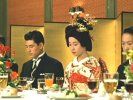Eye For Film >> Movies >> Equinox Flower (1958) Film Review
Is there a director in the history of cinema with a more distinct style than Yasujiro Ozu?
Equinox Flower was Ozu's first colour film and concerns itself with one of his favourite themes - the family and its discontents. The film is set during a time when arranged marriages were being challenged in Japan and pits the emerging youth of the country, full of post war freedom and optimism, against their traditional parents who are finding it difficult to let go of their customs and, ultimately, their children.

A Tokyo businessman, Waturu Hirayama (Shin Saburi), is continually approached by friends for advice - friends who have become powerless as parents and are struggling to impose their will on their daughters. Hirayama's apparent disappointment and resignation regarding his own arranged marriage informs his advice throughout. Consequently, he is often conciliatory and impartial, trying his best to get both sides to see each other's point of view. Neither traditional nor modern in his outlook, instead he takes a humanist approach and strives for harmony amongst the protagonists.
However, when a young man he has never met enters his office and asks for his daughter's hand in marriage, he finds it difficult to adopt this approach for himself and his family. On the one hand, he is initially hurt by the apparent lack of respect and involvement that he feels he should have been afforded by the young couple. He questions his role as a father and feels castrated by this power being taken away, as well as suffering a sense of loss. He has nothing personal against the young man and, after making enquiries, is assured of his good nature. Nevertheless, rather than gaining a son, he's acutely aware that he is losing a daughter and, with that, some of his own identity. Not only losing her in marriage, but also to a new way of life, a new culture in which Hirayama is unsure of his role.
In a broader sense, Equinox Flower also offers an insight into the fast socio-cultural changes in post-war Japan, as it becomes more influenced by capitalism and Western mores. Throughout the film, Hirayama alludes to the fact that his business and workload are becoming increasingly busier. Scenes are often interspersed with images of industrial development and progress, mixed with more traditional scenes of mountain ranges, the countryside and churches. It's also worth noting that it is largely the women who are seen as the advocates of change, trying to find greater equality in a patriarchal society. The men, in comparison, appear passive and confused. Japan itself, like Hirayama, is going through a struggle, a process of change that tries to balance the traditional against the modern.
Stylistically, Ozu's work is remarkable for those willing to give it a chance. All his trademarks are here - zero camera movement, single character shots and evocative editing techniques. His unwillingness to move the camera allows him to frame scenes as if they are photographs, or paintings, where the characters suddenly come to life. His use of colour is accomplished to say the least. Combine that with some wonderful sets and scenery and you would be forgiven for thinking you're watching an old MGM musical. Most remarkable of all, though, are Ozu's trademark tatami-level shots. Using a special camera dolly to simulate the three-foot height of the average person kneeling or sitting on a tatami pad, Ozu creates a way of seeing the world that is specifically Japanese, specifically Ozu.
The style is so unique and effective that it's difficult to imagine films being directed any other way. Buy the DVD boxsets from Tartan, ration yourself to one film a year and you're in for a rare treat.
Reviewed on: 09 May 2006


















